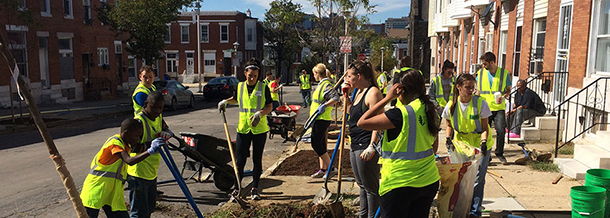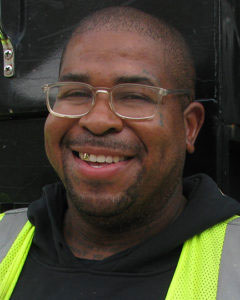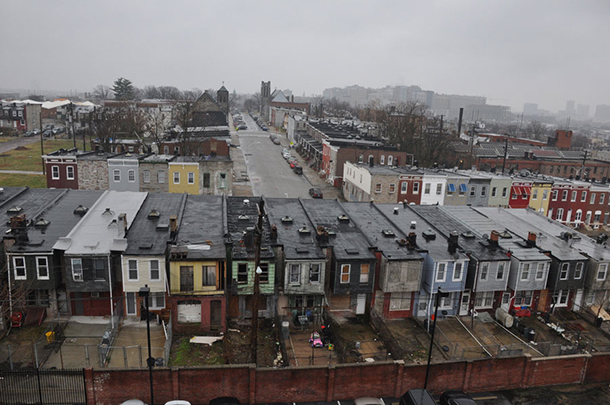From Orange To Green
Air Date: Week of August 11, 2017

Crews with Baltimore Tree Trust plant trees on the sidewalks in front of rowhouses (Photo: Baltimore Tree Trust)
Former prison inmates are planting trees in Baltimore, helping to rejuvenate some of the city’s tough poor and crime-ridden neighborhoods. Alex Smith, head of field operations for the Baltimore Tree Trust spent 15 years in prison. He tells host Steve Curwood how planting urban trees is turning lives around and remaking the city.
Transcript
CURWOOD: From life on the farm, to life in the gritty inner city. In the predominantly black and low-income neighborhoods of Baltimore, violent crime is all too commonplace along bleak asphalt and concrete streets. But an effort to green these neighborhoods is also uplifting residents by putting them to work planting trees. In particular, nonprofits are giving former inmates and would-be drug dealers the opportunity to take ownership of their home turf while earning a living wage.
Among them is Alex Smith, who spent 15 years in prison, but has turned over the proverbial new leaf and now works for the Baltimore Tree Trust. Alex, welcome to Living on Earth.
SMITH: Hey, how are you doing?
CURWOOD: Good. Hey first, tell me what you do as a staff member of the Baltimore Tree Trust?
SMITH: Well, my official title is Field Operations and Outreach. Essentially, I'm a foreman, and I work with fellas and ladies who come from rough backgrounds, and we go out and plant trees all over Baltimore.
CURWOOD: Even when it's hot?
SMITH: Even when it's hot. It's hot today, and I just finished planting some Zelkovas.
CURWOOD: Zelkovas. What are those?
SMITH: They are a good, hardy, street tree. They are one of the most popular trees that we plant.
CURWOOD: Alex, I understand that you were in prison for some 15 years or so before joining the Tree Trust. What was that like and how did you make the most of your time behind bars?
SMITH: I don't really know how to explain prison to anybody who hasn't been there. I can sum it up in two words: It sucks.
CURWOOD: Well, how did you make the most of your time behind bars?
SMITH: Reading, exercising, studying. Behind bars is actually where I learned horticulture and started working with plants. I'm a certified Master Gardener due to Merlin Cooperative extension program.
CURWOOD: And what inspired you to get into working with plants, working with gardens?

Alex Smith leads the field operations and outreach effort at Baltimore Tree Trust. (Photo: Baltimore Tree Trust)
SMITH: Well, they had a little horticulture program. It was a guy that came from Frostburg University, Dr. Wayne Yoder. He would come there and teach about plants, but it was not like we could put it into practical application. We were just learning about it. But when we approached the staff about a garden, this idea started growing that we could actually transform the grounds and that we could use what we were learning in the classroom inside of the prison.
CURWOOD: How did you feel once you started that horticultural program, there in prison, that you were going to green the place?
SMITH: It was definitely a good feeling. It was a feeling that if you know, one, that we were even paid attention to. You know, a lot of times I've written letters to different organizations, and they went unanswered or they were simply returned, so, for us to actually have somebody starting to pay attention to us, that exciting to begin with. It was a foundation that actually helped us out, the TKF Foundation. They were already doing meditation gardens around the city. Their only requirement was that we somewhere put a meditational Peace Garden. So we did that right out in front of the chapel.
CURWOOD: At the prison.
SMITH: Yes, in western Maryland, WCI.
CURWOOD: So you build these gardens in the prison, and then you get out. How did you find your job with the Baltimore Tree Trust?

Baltimore Tree Trust cares for the trees they plant for the first two years (Photo: Baltimore Tree Trust)
SMITH: Well, I was working a couple of jobs. At the time I was working construction, but you know in construction that you have a lot of downtime because of weather or what have you, so what I was doing was landscaping on the side. Someone suggested I buy a pick-up, that I shouldn't let the landscaping skill just sit on the shelf, so I took their advice, and because I volunteer at the Center for Urban Families, I would show some of the people around there, some of the stuff that I could do. Part of it was in hopes to get a couple of new clients, but I was also proud of my work. So, I guess Dan walked in and talked to one of the career counselors. Dan Miller, he's the Executive Director of the Baltimore Tree Trust, my boss, he walked in looking for somebody who could work with the Baltimore Tree Trust, and my name came up, and they said I know someone who does that work.
CURWOOD: Now, how do you recruit other people, who've had similar experiences, spent time in jail? How do you recruit them to help you plant trees?
SMITH: Well, everywhere I go in Baltimore and I'm asked, “Are you hiring?” So it's pretty easy when I'm in the Baltimore Tree Trust truck, and I have a vest on, and I'm out working. It's pretty easy to get people who say they're interested in jobs, but mostly I come to the Center for Urban Families and get people that have come through STRIVE program.
CURWOOD: STRIVE. Tell me more about STRIVE.
SMITH: STRIVE is an employment readiness program which basically sharpens up or refreshes people’s soft skills, and it helps them not only get jobs but keep jobs.
CURWOOD: Alex, why plant trees in Baltimore?

Baltimore’s economically-depressed neighborhoods largely lack trees (Photo: U.S. Department of Agriculture, Flickr CC BY 2.0)
SMITH: One, it's for beautification. You know, you put trees in a block, it changes the whole environment. It's not just concrete and asphalt and brick, but two, it definitely helps our environment. They trap rainwater and the bad stuff that it doesn't get filled by the tree pits and the trees and roots themselves, all the stuff goes right into the Chesapeake Bay. But beautification and how it changes what people see when they look out their window, that's the most important part to me.
CURWOOD: Is there a place with trees in Baltimore that's a particular favorite of yours?
SMITH: Well, it's a place that I haven't planted, but it's a small street near York Road in Baltimore that has full grown trees that just canopy the whole street, like it reminds you of maybe what the block looked like some 56 years ago. Pretty amazing to see these trees. Until I started working for the Baltimore Tree Trust I never really paid attention to them. That's what I envision when I'm out there planting a tree, that one day the tree that I plant will look like that. And we plant some of the same varieties, so, you know, I'll be checking it out in 30 years, to see.
CURWOOD: How do people in the community respond to the work that you're doing now, planting trees?
SMITH: For the most part, we definitely have community support. It is not just the people who are seeking employment or are interested in that way. It is just from normal, everyday people who just like to see trees, like to see people working, but we do have those people who we have to convince that planting trees in their neighborhood, planting trees in front of their house is a good thing.
There's a lot of myths about trees bring rats, trees strangle pipes. That's like the number one issue that we get, and some people just they just don't want them because of bugs, mosquitoes. We get all kind of things. When we are out in the community we are definitely armed with information and sometimes, you know, even if you show people, they still don't want the tree.
CURWOOD: What kind of ownership, what kind of responsibility for the trees do people in neighborhoods take, once you plant the tree?
SMITH: Well, Baltimore Tree Trust, we give them a bucket that has a lot of pointers on it about trees. We pass out flyers. Part of my job is to do outreach. So, it's not just outreach with the fellas that I hire to help me plant these trees, but it’s outreach in the community to dispel some of the myths about the trees and to teach people how to care for them. But we also maintain the trees for two years after we plant them. So, people in the neighborhood, they see us maintaining the trees and pruning the trees and making sure that we care for the tree, so any chance that I can, I'm always giving people advice and giving them pointers and tips on how to take care of the tree.
Some people have actually taken ownership of the trees, you know, “That's my tree.” Even some neighbors squabble over whose tree it is. For the people who care about the neighborhood and care about the way the neighborhood looks, we get a pretty good response from those people.
CURWOOD: Now Alex, many neighborhoods you work in are mostly African-American, but the Baltimore Tree Trust is mostly a white institution. How do people respond to that?
SMITH: I've never had anybody directly have a problem with it. I do know that in Baltimore City people do have a feeling that there's a lot of white organizations that come in the city without asking, do people want the services or products and things like that, and they just shove them down people's throats. That's what people believe in the neighborhood for the most part.
I would like to think that, because I was presented this opportunity, it is my chance to try to change that, change that perception. So, what I'd do is, I go and knock on people's doors, and I say, “Hey, a tree is coming.” I tell them the laws concerning the tree, but I also ask their opinion about it, and sometimes, if they are adamantly against the tree, we don't plant it. I definitely make sure that the community in which we're working in are considered. It’s not that they will open the door one day and see 20 people standing in front of house, planting trees.
CURWOOD: Imagine some people might be worried about gentrification, that planting trees could raise property values, and end up pushing out the very people who are supposed to benefit.
SMITH: That's a definite concern, and a lot of people do believe that. They do believe that the trees didn't come until the property values starting raising in some of the neighborhoods that I worked in, and nobody cared about the sidewalks or the streets until people from outside started investing and remodeling some of the bigger homes in the neighborhood. I really don't know the answer to that, but I know that the Baltimore Tree Trust, we plant trees for everybody.
And I don't see any bulldozers or tanks pushing people out of the neighborhood. Even though I can say that, you know, when you raise prices to a certain level you will squeeze out certain buyers, you know, and that's an issue that is way above Tree Trust. That's an issue that should concern everybody, everybody that is looking to keep Baltimore a city that welcomes everybody. That’s something that we all have to work together on.

The Western Correctional Institution in Maryland, where Alex Smith served 15 years. (Photo: Jon Dawson, Flickr CC BY-ND 2.0)
CURWOOD: So, Alex, this has worked well for you, helped you turn your life around. What about other prisoners and former prisoners, people getting out of jail, trying to establish themselves in communities again?
SMITH: Well, I hope that I'm not an anomaly. I would hope that eventually this catches on because every day that I'm out in the street I see opportunity. You know, while I'm planting trees, I see the tree pits that aren't being taken care of. I see the trees that have been planted years ago that aren't being cared for. I see the litter that’s in the tree pits. All those are unemployment opportunities. You know, if the government, the communities, if they're just a little creative and can see that the opportunities that I see while I'm out there in the street, I think that it definitely can work for other people.
CURWOOD: Before you go, Alex, tell me about your vision for the future of Baltimore's environment, including the trees.
SMITH: My vision for Baltimore and myself is that I learn more about the trees. I learn more about how they impact our environment. I learn more about how I can help other people. I mean, I'm a servant for my community, and I feel like I'm blessed to be given this opportunity, so every day that I go out in the street is, for me, it's an opportunity to give back.
You know, I took away so much from the streets and from the neighborhoods. I was the bad element at one time. I just hope that I can have an impact, and I can help other people the way I've been helped.
CURWOOD: Alex Smith leads field operations and outreach for the Baltimore Tree Trust. Alex, thanks so much for taking the time with us today.
SMITH: No problem. Any time.
Links
Read Rona Kobell’s story for the Chesapeake Bay Journal about ex-cons in green jobs
Living on Earth wants to hear from you!
Living on Earth
62 Calef Highway, Suite 212
Lee, NH 03861
Telephone: 617-287-4121
E-mail: comments@loe.org
Newsletter [Click here]
Donate to Living on Earth!
Living on Earth is an independent media program and relies entirely on contributions from listeners and institutions supporting public service. Please donate now to preserve an independent environmental voice.
NewsletterLiving on Earth offers a weekly delivery of the show's rundown to your mailbox. Sign up for our newsletter today!
 Sailors For The Sea: Be the change you want to sea.
Sailors For The Sea: Be the change you want to sea.
 The Grantham Foundation for the Protection of the Environment: Committed to protecting and improving the health of the global environment.
The Grantham Foundation for the Protection of the Environment: Committed to protecting and improving the health of the global environment.
 Contribute to Living on Earth and receive, as our gift to you, an archival print of one of Mark Seth Lender's extraordinary wildlife photographs. Follow the link to see Mark's current collection of photographs.
Contribute to Living on Earth and receive, as our gift to you, an archival print of one of Mark Seth Lender's extraordinary wildlife photographs. Follow the link to see Mark's current collection of photographs.
 Buy a signed copy of Mark Seth Lender's book Smeagull the Seagull & support Living on Earth
Buy a signed copy of Mark Seth Lender's book Smeagull the Seagull & support Living on Earth

